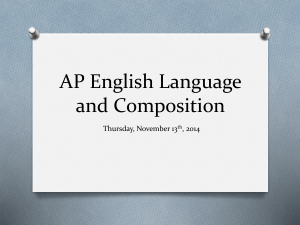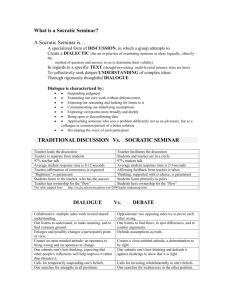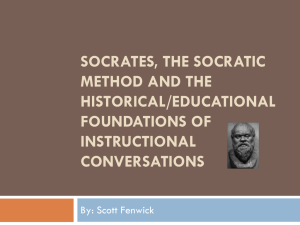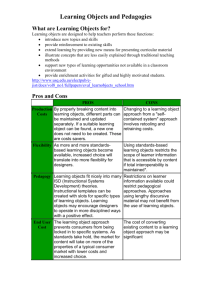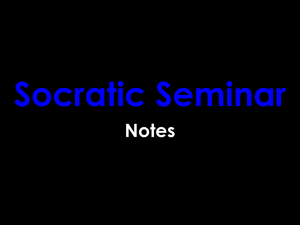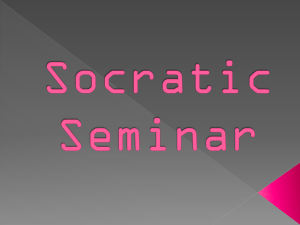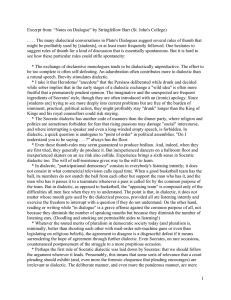File - Ms. Bicknell's Classroom
advertisement
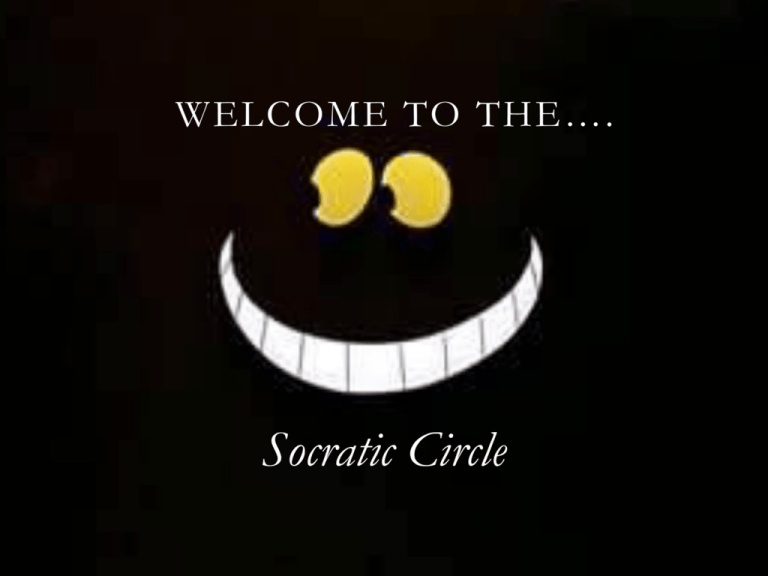
WELCOME TO THE…. Socratic Circle WHAT DOES SOCRATIC MEAN? YOU ASK….. The word “Socratic” comes from the name Socrates (ca. 470-399 B.C.), a Classical Greek philosopher who developed a Theory of Knowledge. WHAT WAS SOCRATES' THEORY OF KNOWLEDGE? Socrates believed that the answers to all human questions and problems can be found within us. But we are often unaware of the answers and solutions we posses Socrates was convinced that the best way to discover those answers & discover reliable knowledge was through the practice of disciplined conversation. He called this method the “dialectic.” WHAT DOES DIALECTIC MEAN? Dialectic is the art or practice of examining opinions or ideas logically often by the method of question and answer, so as to determine their validity (truth) HOW DID SOCRATES USE THE DIALECTIC? Socrates believed that through the process of dialogue, where everyone was forced to clarify their ideas, the final outcome of the conversation would be a clear statement of what was meant. The technique appears simple but it is very hard to do! Socrates would pretend ignorance about a subject and try to draw out from the other person his fullest possible knowledge about it. Socrates’ assumption was that by continually correcting incomplete or inaccurate ideas through discussion, you could get the truth out of anyone. WHAT IS A SOCRATIC CIRCLE? A Socratic circle (aka Socratic seminar) is a process to try to understand info by creating the dialectic in class. In a Socratic circle, participants seek deeper understanding of complex ideas through thoughtful dialogue, rather than by memorizing bits of information. A Socratic Circle is NOT A DEBATE!!!!! The goal of this activity is to have participants work together to construct meaning & arrive at an answer, not for one student or one group to “win the argument.” HOW DOES A SOCRATIC CIRCLE WORK? 1. On the day before a Socratic Circle is scheduled, the teacher hands out a discussion topic or a short passage of text. 2. The students spend time reading, analyzing, researching and taking notes over the section of text/ discussion topic. 3. At the beginning of class the next day, students form a circle. 4. One student will be the recorder. 5. One student will be the monitor. CONT’D 5. Since this is a team effort, there will be a team grade. The whole class will get the same grade, with two exceptions: students who do not participate at all will be marked down; other students who perform truly exceptional group-benefit feats - for example by “saving” or immensely uplifting a discussion that is going bad - will be eligible for independent work credit. KEEP IN MIND….. A discussion for which everyone would receive an “A” would look like this: - Everyone participates, and more or less equally. - Moves at a good pace - Students don’t talk over each other - There is an attempt to resolve questions and issues before moving on to new ones. - The loud do not dominate; the shy are encouraged. Everyone is clearly understood. - Students are animated, sincere, helpful. - The conversation is lively. - When the process is not working, the group adjusts. Those unhappy with the process say so. - Students take risks and dig for new meanings. - Students back up what they say with examples, quotations, etc. - All students come well-prepared. - The text is referred to often. Students aren’t repetitive or negative I’M SO EXCITED!!!!!
